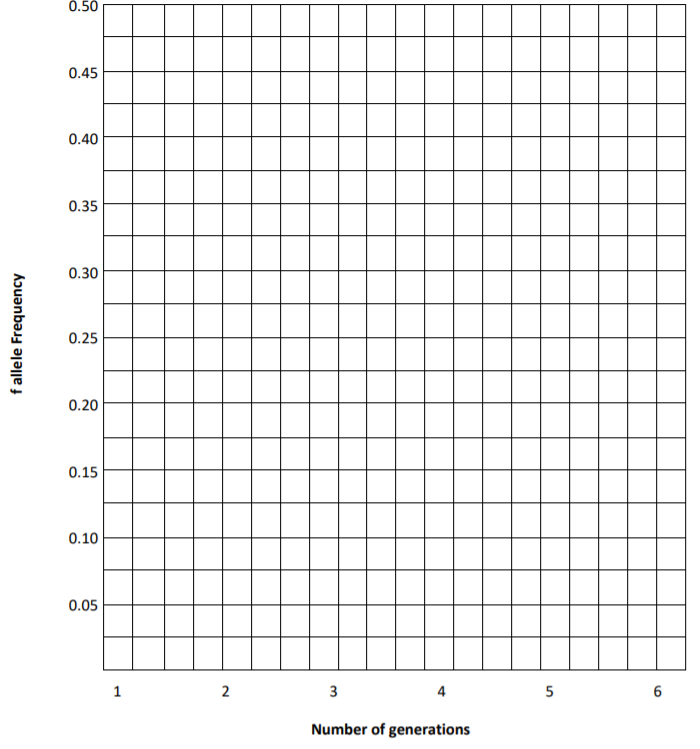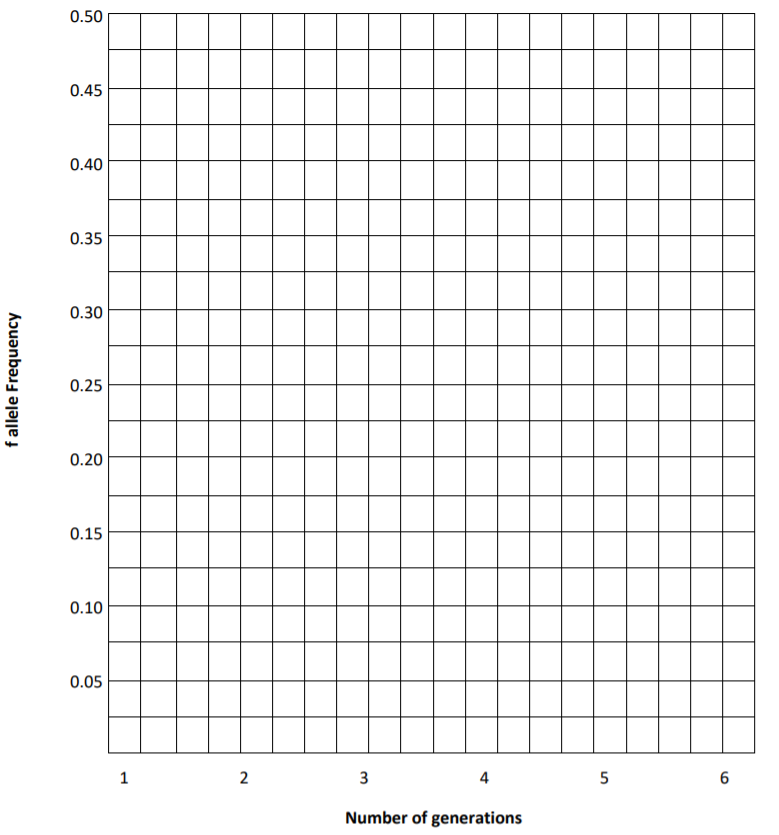Lab 1: Cystic Fibrosis and Evolutionary Changes
( \newcommand{\kernel}{\mathrm{null}\,}\)
Natural Selection:
In humans, cystic fibrosis is an inherited disease due to an autosomal recessive gene located on chromosome #7. In the most common defective allele, three base pairs are deleted and a single phenylalanine is missing. Affected individuals carry two of the recessive alleles for the disease (genotype ff) and, as a result, form extremely thick mucus in their respiratory systems and elsewhere in the body. Their lungs are susceptible to frequent infections while the disease is progressive and eventually fatal. Usually the victims die in their teens or early twenties, and so do not reproduce. Among whites, one person in 20 is a carrier, who is heterozygous (Ff) for cystic fibrosis.
Severe natural selection has operated on the gene pool for cystic fibrosis (f) and normal Alleles (F) over the centuries. The affected individuals do not reproduce and do not pass on their genes. New cases arise only when both parents are heterozygous or through new mutations in a "normal" parent.
In the following exercise, you will compare the effects of natural selection alone and natural selection plus negative eugenics on the frequency of the f allele in a model system. Among the children of marriages between heterozygous carriers of the f allele and genetically normal individuals, the frequency of the f allele should be 25%, the same as in the parents. We will use that frequency at the start of both this and the following experiments.
First Round = First Generation
In this experiment, there will be complete selection against the recessive genotype that is expressed as the affected cystic fibrosis phenotype. The homozygous (FF) and the heterozygous (Ff) genotypes both have the normal phenotype and are not selected against. Both will, therefore, contribute to the next generation.
- Obtain a small plastic bag and count out 75 light beads and 25 dark beads. These 100 beads represent your initial gene pool. This is the gene pool that would be generated by marriages between heterozygous carriers and homozygous normal individuals.
- Shake up the beads to simulate random mixing of the gametes during the first generation of reproduction.
- Reach into the bag and (without looking!) take out two beads: This is the first individual.
- Set this pair of beads aside and repeat 49 times until you have drawn all beads, arranging the FF, Ff, and ff genotypes in groups as you draw. This represents 50 individuals. Remember, individuals have two copies of each gene!
- Select against the homozygous (ff) individuals by removing all of their alleles from the pool. You only will be left with the FF and Ff individuals.
- Count up the number of light and dark beads left in the pool and calculate the percentage and frequency of each. The frequency is determined by finding the total # of beads, then divide by the # in each category.
- Enter the results in the Table at the end of this exercise under Generation 1. (For help and guidance refer to the sample chart included at the end of the exercise.)
Second Round = Second Generation
- Begin the second round by replenishing your beads so that you have 100 beads with the same percentages of light and dark beads that you had at the end of Round (Generation 1). In the sample example provided, the new percentages were 80% light and 20% dark, so you would add beads to give 80 light and 20 dark.
- Shake up the beads.
- Select 50 new pairs.
- Remove all the ff individuals.
- Calculate the percentages and frequencies of light and dark beads left after selection and enter the results in the table under Generation 2.
Third Round = Third Generation, etc.
- Begin the third round by replenishing your beads so that you have the new percentages and repeat as described under the second round until you have drawn and selected against all five generations.
When you have finished five rounds, you will be tired of drawing beads, but you will have enough data to make a meaningful graph of the decline in the frequency of the f allele over five generations.
- Use the grid provided at the end of this exercise to plot the frequency of the f allele versus the number of generations.
Note
The first table demonstrates the practice calculations.
W = white; B = black
| Practice Calculations | ||||||||
| F (White) | f (Black) | |||||||
| Rounds | # to start | # W after selection | Total # W+B after selection | New Frequency | # to start | # B after selection | Total # W+B after selection | New Frequency |
| Initial | 75 | 75 | 92 | 0.82 | 25 | 17 | 92 | 0.18 |
| Generation 1 | 82 | 18 | ||||||
| Generation 2 | ||||||||
| Generation 3 | ||||||||
| Generation 4 | ||||||||
| Generation 5 | ||||||||
| Fluctuation in Frequency of Cystic Fibrosis Allele Due to Selection Against It. Removing Homozygotes Only. | ||||||||
| F (White) | f (Black) | |||||||
| Rounds | # to start | # W after selection | Total # W+B after selection | New Frequency | # to start | # B after selection | Total # W+B after selection | New Frequency |
| Initial | ||||||||
| Generation 1 | ||||||||
| Generation 2 | ||||||||
| Generation 3 | ||||||||
| Generation 4 | ||||||||
| Generation 5 | ||||||||
Negative Eugenic:
In this experiment, you will assume that affected individuals with the ff genotype will not reproduce. Also, assume that 50% of the heterozygous individuals will refrain from reproducing or from passing on the f allele. The remaining heterozygotes and homozygotes for the normal allele will contribute to the next generation.
- Obtain a small plastic bag with 75 light beans and 25 dark beads. You may also need a coin to flip. These 100 beads represent your initial gene pool. This is the gene pool that would be generated by marriages between heterozygous carriers and homozygous normal individuals.
- Shake up the beads to simulate random mixing of the gametes during the first generation of reproduction.
- Reach into the bag and (without looking!!!) take out two beads.
- Set this pair of beads aside and repeat 49 times until you have drawn all beads, arranging the FF, Ff, and ff genotypes in groups as you draw.
- Select against the ff individuals by removing all of their alleles from the pool; select against the Ff individuals by removing one half of them from the gene pool. If you have an odd number of heterozygotes, flip a coin to decide whether to remove the last one. You will be left with one half of the Ff individuals and all of the FF individuals.
- Count up the number of light and dark beads left in the pool and calculate the percentage and frequency of each exactly as you did in the first part of the exercise.
- Enter the results in the appropriate table at the end of this exercise.
| Fluctuation in Frequency of Cystic Fibrosis Allele: Negative Eugenics; Removing Homozygotes and 50% of Heterozygotes | ||||||||
| F (White) | f (Black) | |||||||
| Rounds | # to start | # W after selection | Total # W+B after selection | New Frequency | # to start | # B after selection | Total # W+B after selection | New Frequency |
| Initial | ||||||||
| Generation 1 | ||||||||
| Generation 2 | ||||||||
| Generation 3 | ||||||||
| Generation 4 | ||||||||
| Generation 5 | ||||||||
Questions:
1. What is the chance that two heterozygous parents will produce an affected child?
2. Why might the frequency of the f allele fail to drop over time?
3. Did you see a rapid effect of natural selection alone on the frequency of the f allele in the first experiment? Did the allele disappear? Why not?
4. Did negative eugenics cause the frequency of the f allele to decline more rapidly in the second experiment? Why?
5. Why doesn't cystic fibrosis decrease and eventually disappear of its own accord?
6. In some diseases, the affected individual has the ability to reproduce. Suppose there was a genetic counseling program that was attempting to lower the frequency of such diseases through negative eugenics. Would you advise the counseling program to concentrate its efforts on the affected individuals, or should both the carriers and affected individuals receive counseling? Explain your answer, using your graphs as evidence.
7. What is the dependent variable in this experiment? (Hint: what changes?)
8. What is the independent variable? (Hint: what causes it to change?)
9. A test for the f allele in carriers exists. Should prospective parents consider taking it?
Graphs:
Selection against the f allele by phenotype.
Individuals with the recessive phenotype did not reproduce.

Selection against the f allele by phenotype and genotype.
Individuals with the recessive phenotype and one-half of the heterozygous carriers did not reproduce.



